
IMGS 682 Spring 2016 - Homework 1: Linear Algebra, Classifiers, and PCA
Author:
Sanjana
Last Updated:
10 years ago
License:
Creative Commons CC BY 4.0
Abstract:
homework

\begin
Discover why over 20 million people worldwide trust Overleaf with their work.